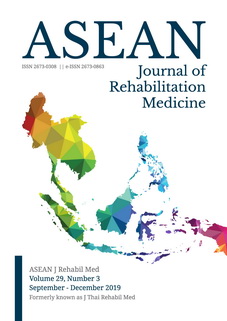Prevalence and Potential Associated Factors of Poststroke Depression
Keywords:
depression, disability, prevalence, strokeAbstract
Objectives: To study the prevalence and potential associated factors of poststroke depression (PSD).
Study design: Cross-sectional study.
Setting: Department of Rehabilitation Medicine, Faculty of Medicine Siriraj Hospital, Bangkok, Thailand.
Subjects: First ever stroke patients age 45 years old with duration of stroke from 2 weeks to 2 years.
Methods: The included patients were assessed with the Barthel Index (BI) and the Modified Rankin Scale for Neurologic Disability (MRS). A psychiatric interview according to the diagnostic and statistical manual of mental disorders classification, fifth edition (DSM-5TM) criteria was performed by a psychiatrist. Prevalence was described and potential associated factors of PSD were analyzed with multivariate forward stepwise logistic regression.
Results: Of 115 patients, there were 63 males (54.8%). Mean age was 64 (SD 10) years old. Median duration of stroke was 59 days. The prevalence of PSD was 20%, 8 of them (6.9%) were diagnosed with major depressive disorder and 15 of them (13.1%) had other depressive disorder. The univariate analysis revealed those with PSD were more disabled according to the MRS (p = 0.04) and had more dependent grooming according to the BI (p = 0.003). With multivariate analysis,only grooming was associated with PSD (odd ratio 4.9; 95%CI 1.6-14.8).
Conclusion: The prevalence of poststroke depression within the first 2 years of those with the first stroke and aged 45 years or older was 20%. Dependence in grooming was the only factor significantly associated with poststroke depression.
References
2. Hackett M, Pickles K. Part I: frequency of depression after stroke: an updated systematic review and meta-analysis of observational studies. Int J Stroke. 2014;9:1017-25.
3. Werheid K. A two-phase pathogenic model of depression after stroke. Gerontology. 2016;62:33-9.
4. Robinson R, Jorge R. Post-Stroke Depression: a Review. Am J Psychiatry. 2016;173:221-31.
5. Tantibhaedhyangkul P, Kuptniratsaikul V, Tosayanonda O. Preva-lence and associated factors of poststroke depression. J Thai Rehabil. 1997;7:64-71.
6. Davidsen A, Fosgerau C. What is depression? Psychiatrists’ and GPs’ experiences of diagnosis and the diagnostic process. Int J Qual Stud Health Well-being. 2014;9:24866.
7. Griffiths D, Sturm J. Epidemiology and etiology of young stroke. Stroke Res Treat. 2011;2011:209370.
8. Train the Brain Forum Committee. Thai mental state examination. Siriraj Hosp Gaz. 1993;45:359-74.
9. American Psychiatric Association. Diagnostic and Statistical manual of mental disorders –DSM-5. 5th ed. Washington DC: American Psychiatric Press; 2013.
10. Mahoney F, Barthel D. Functional evaluation: the Barthel index. Md State Med J. 1965;14:61-5.
11. Wade D, Hewer R. Functional abilities after stroke: measurement, natural history and prognosis. J Neurol Neurosurg Psychiatry. 1987;50:177-82.
12. Rankin L. Cerebral vascular accidents in patients over the age of 60. II. Prognosis Scott Med J. 1957;2:200-15.
13. Swieten J, Koudstaal P, Visser M, Schouten H, Gijn J. Interobserver agreement for the assessment of handicap in stroke patients. Stroke. 1988;19:604-7.
14. Masskulpan P, Riewthong K, Dajpratham P, Kuptniratsaikul V. Anxiety and depressive symptoms after stroke in 9 rehabilitation centers. J Med Assoc Thai. 2008;91:1595-602.
15. Ojagbemi A, Akpa O, Elugbadebo F, Owolabi M, Ovbiagele B. Depression after stroke in sub-saharan africa: a systematic review and meta-analysis. Behav Neurol. 2017;2017:4160259.
16. Shi Y, Yang D, Zeng Y, Wu W. Risk factors for post-stroke depression: a meta-analysis. Front Aging Neurosci. 2017;9:218.






